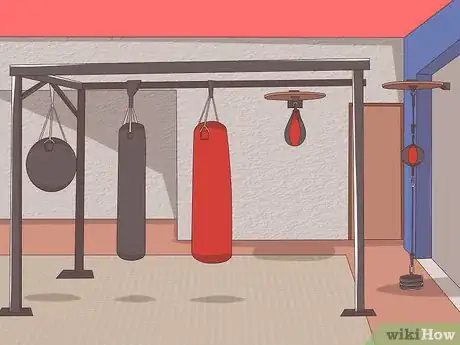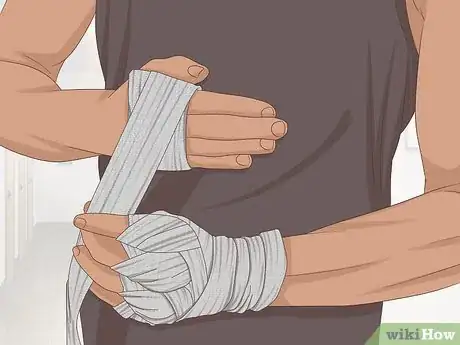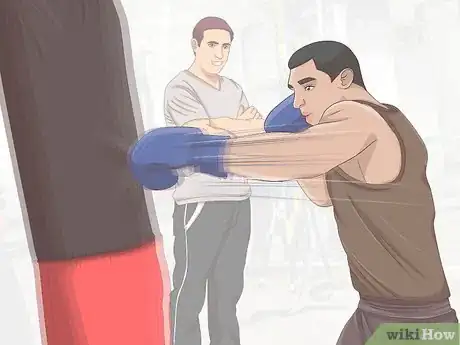This article was co-authored by David Engel. David Engel is a Muay Thai Instructor and Self Defense Trainer based in the San Francisco Bay Area. With over 15 years of martial arts instruction and training experience, David runs California Martial Athletics with co-owner Joe Chernay. He has created and maintained martial arts programs at Rise Combat Sports in San Francisco and Round 5 Martial Arts Academy in San Leandro, with a mission to provide students with a level of comfort and competency that manifests both within and outside the martial arts context. He is also a registered cornerman for amateur and pro competitors under the IKF (International Kickboxing Federation). David was the youngest apprentice instructor of the Thai Boxing Association of America under Ajarn Chai Sirisute (2009), and was a top-ranked amateur competitor in his weight class (127-130 lb) in California between 2013 and 2015.
This article has been viewed 20,119 times.
Although going to a boxing gym may seem like a simple task, it requires a fair amount of research and some trial and error. You first need to search for gyms in your area and visit them in order to see which will work best for your needs. If you want to become a professional fighter, you should then critically evaluate the equipment and professional fighters at each gym in order to find a quality training location. Finally, you will need to find a trainer and get the appropriate gear so that you can begin honing your boxing skills.
Steps
Finding a Gym
-
1Consider different types of gyms. Think about why you want to start boxing and what you expect out of your boxing experience. Are you interested in becoming a professional boxer or just looking to get in better shape? If you are simply looking to get into shape, a boxing gym may be a good choice. However, you can also take boxing classes at your local YMCA or fitness club. If you want to become an amateur or professional boxer, you will need to join a boxing gym and receive personal training.[1]
- If you are a beginner, taking a few fitness boxing classes might be a good way to test your interest in the sport.
- Don't go into boxing because you want to fight—go into boxing because you want to learn a martial art. It's good for your body and it builds confidence.[2]
-
2Search online. Once you have determined what kind of gym you want to join, you should begin looking around for gyms. Do a simple Google search of boxing gyms in your area and visit a few websites. Many gyms will give you a rudimentary list of their services and what you might expect at their gym.
- Be sure to check out the fees of prospective gyms. Most pure boxing gyms only charge a small monthly fee. However, you will also have to pay for a trainer.
- If you want to be a professional fighter, look for gyms that advertise their professional and amateur fighters. You should also be able to find info about trainers as well.
Advertisement -
3Check out multiple gyms. Once you have checked out some places online, you should go visit the prospective gyms in person. Get a feel for the atmosphere and determine which place is the most appealing. Be sure to visit multiple gyms and try not to join the first gym you visit. You want to weigh your option.[3]
- You should take advantage of day passes or trial memberships to test out individual gyms. Working out in a gym is the best way to determine if you will like being there.
- Look for a gym that will offer you a strong support system. That can help you take your martial art to the next level.[4]
-
4Evaluate the equipment. A high-quality boxing gym will have all of the equipment that you will need to train as a fighter. The gym should have heavy bags, speed bags, double-end bags, a ring, a timer, and free weights. If any of these things are not available, you might want to consider another gym.[5]
- However, do not be quick to judge the quality of the equipment. New equipment does not necessarily indicate the quality of a gym. A good gym has equipment that is worn from use but still taken care of.
-
5Talk with trainers. While you are checking out the various gyms, make a point to talk to prospective trainers. Ask the gym staff or the person at the front door if there are any trainers that you can meet. When you talk to the trainers, ask them about their fees, hours, and how many clients they have. This will give you an idea of how much attention your trainer will give you and how much it will cost to work with them.
- You should take advantage of free trial classes to work with potential trainers. Try to find someone that like and who motivates you. A good coach will look out for your best interest and will be interested in helping you advance as a martial artist.[6]
- You will also want to find a gym that has enough trainers available to give you the time and attention you need.[7]
- Be sure to ask potential trainers questions like “How long have you been training?” and “Who did you train under?” You should also ask about how many clients they are currently training.
-
6Look for professional fighters. A quality boxing gym will have a clientele of professional fighters. Start online and look for gyms posting about their amateur and professional fighters. When you visit the gyms, look for local pros using the ring and sparring with their training team. A stable of good fighters is a strong indication of a gym’s quality.
- The downside of training at a high profile gym is that the pros will get priority use of the equipment over regular joes like yourself. If you want to have regular access to the ring and sparring equipment, you might want to go for a middle of the road gym.
-
7Pay attention to the memorabilia on the walls. Most serious boxing gyms will post memorabilia from their fighters on the walls. These will be newspaper clippings, fight boards, and pictures of the fighters. The more accomplished the fighters, the more mementos there will be on the walls. Although it is not a guarantee of a gym’s quality, you can feel confident that a good gym will produce good fighters.<
-
8Attend a local fight. If you want to gauge the quality of a gym, you might want to evaluate fighters that trained there. One of the best ways to do that is by attending some fights and paying attention to how various gyms’ fighters fare in the ring. If a certain gym’s fighters seem to do particularly well, you can reasonably assume that they are getting good training.
Signing Up at the Gym
-
1Join the gym. Once you pick a gym, you will need to become a member. You will need to pay a monthly fee to use the gym's facilities. Compared to a fitness center, this fee is significantly lower. However, you may have to pay additional fees for specific classes. You will also have to pay extra for a trainer if you decide to go that route.[8]
- Typically, the only information that a gym will need is your address, phone number, and an email address.
-
2Pick some classes. If you join a gym that offers classes, you should enroll in them as soon as possible. Many gyms offer introductory classes that will teach you the basics of boxing, such as footwork and stance. Some gyms require that their students take these classes before they start training. Look at the gym’s offerings and pick the classes that fit your schedule and skill level.[9]
- If you are paying to work with a trainer, you may not need classes. In fact, a trainer may not appreciate someone else giving you boxing training.
-
3Sign up for body weight exercises. Because professional boxers have to maintain their weight in order to fight at specific weight classes, they closely control their body weight. Besides typical classes on fighting technique, your gym may also offer courses about dieting and proper weight management. A good weight management course will help you manage your weight and eat healthier.[10]
- You should avoid any unhealthy weight management practices like purging, fasting, or dehydration. These can cause significant health problems.[11]
Getting Started in a Boxing Gym
-
1Get a trainer. Picking a trainer may go hand-in-hand with determining what gym to join. Ideally, you will join a gym because you find a trainer that you like. A trainer will put you on a workout regimen and help you hone your technique. They are essential to your progression as a fighter.
- Observe different trainers at the gym and see if you think any of them would work with your boxing style. If so, ask them if they could be your trainer or sign up for training sessions with them at the front desk.
-
2Buy the gear. Once you have a boxing home and some instruction, you should get the appropriate gear. You will need a quality pair of boxing gloves, a good jump rope, and some hand wraps. If you are sparring, you will also need head gear, a groin guard, and a gum shield. Finally, you may also want to invest in a good pair of boxing shoes.[12]
- Many gyms have gear available for their clients to use. However, it is often worn out and unhygienic to use.
- Talk with your trainer about what gear they think you should get.
-
3Learn to wrap your hands. Applying boxing wraps will help you avoid seriously injuring your hands. Your trainer will likely teach you how to apply your wraps. In fact, you should have an experienced person wrap your hands for you until you are competent at the task.[13]
- Wearing hand wraps gives your bones and joints extra support when you punch solid objects.
-
4Find a sparring partner. After you have spent some time at the gym, look for people that are at your skill level. You should get to know these people and practice sparring with them. Sparring is a great way to get some in-ring experience while working on your speed, accuracy, timing, and technique.[14]
- Your trainer may also hook you up with people to spar with.
- Sparring with a significantly more experienced fighter may be an unpleasant experience. They will likely wear you out and beat you up a little.
-
5Watch the professionals. The professional fighters in your gym are a great resource for learning more about the sport. Pros will demonstrate their elite skill and knowledge of the sport. Take every advantage you have to watch them spar, work the bags, and practice their footwork. Watching them move will help you hone your own technique.[15]
-
6Practice the basics at home. You can practice your footwork and shadowbox anywhere, as long as you have enough space. If you want to get serious about boxing at home, you should buy a 75- to 100-pound punching bag. This will allow you to do some basic punching and footwork when you are not at the gym.[16]
- If you are already participating in training sessions multiple times a week, do not do extra bag training at home. You can overwork your hands, resulting in injuries. Instead, emphasize cardio workouts and strength training.
Expert Q&A
-
QuestionWhat should I look for when I'm choosing a boxing gym?
 David EngelDavid Engel is a Muay Thai Instructor and Self Defense Trainer based in the San Francisco Bay Area. With over 15 years of martial arts instruction and training experience, David runs California Martial Athletics with co-owner Joe Chernay. He has created and maintained martial arts programs at Rise Combat Sports in San Francisco and Round 5 Martial Arts Academy in San Leandro, with a mission to provide students with a level of comfort and competency that manifests both within and outside the martial arts context. He is also a registered cornerman for amateur and pro competitors under the IKF (International Kickboxing Federation). David was the youngest apprentice instructor of the Thai Boxing Association of America under Ajarn Chai Sirisute (2009), and was a top-ranked amateur competitor in his weight class (127-130 lb) in California between 2013 and 2015.
David EngelDavid Engel is a Muay Thai Instructor and Self Defense Trainer based in the San Francisco Bay Area. With over 15 years of martial arts instruction and training experience, David runs California Martial Athletics with co-owner Joe Chernay. He has created and maintained martial arts programs at Rise Combat Sports in San Francisco and Round 5 Martial Arts Academy in San Leandro, with a mission to provide students with a level of comfort and competency that manifests both within and outside the martial arts context. He is also a registered cornerman for amateur and pro competitors under the IKF (International Kickboxing Federation). David was the youngest apprentice instructor of the Thai Boxing Association of America under Ajarn Chai Sirisute (2009), and was a top-ranked amateur competitor in his weight class (127-130 lb) in California between 2013 and 2015.
Muay Thai Instructor & Self Defense Trainer It's important to have a great support system, so look for a gym with a strong team spirit. Also, when you're choosing a coach, look for someone who has your best interest in mind, and who really seems to care about helping you advance as a martial artist.
It's important to have a great support system, so look for a gym with a strong team spirit. Also, when you're choosing a coach, look for someone who has your best interest in mind, and who really seems to care about helping you advance as a martial artist.
References
- ↑ http://boxing.isport.com/boxing-guides/how-to-choose-a-boxing-gym
- ↑ David Engel. Muay Thai Instructor & Self Defense Trainer. Expert Interview. 5 May 2020.
- ↑ http://boxing.isport.com/boxing-guides/how-to-choose-a-boxing-gym
- ↑ David Engel. Muay Thai Instructor & Self Defense Trainer. Expert Interview. 5 May 2020.
- ↑ http://boxing.isport.com/boxing-guides/how-to-choose-a-boxing-gym
- ↑ David Engel. Muay Thai Instructor & Self Defense Trainer. Expert Interview. 5 May 2020.
- ↑ http://boxing.isport.com/boxing-guides/how-to-choose-a-boxing-gym
- ↑ http://www.moneycrashers.com/health-benefits-boxing-workouts/
- ↑ http://www.moneycrashers.com/health-benefits-boxing-workouts/
- ↑ http://www.moneycrashers.com/health-benefits-boxing-workouts/
- ↑ https://www.ncbi.nlm.nih.gov/pmc/articles/PMC3419563/
- ↑ http://www.mightyfighter.com/how-to-start-boxing-in-7-steps/
- ↑ http://www.titleboxing.com/news/how-to-wrap-your-hands-in-10-easy-steps/
- ↑ http://www.mightyfighter.com/how-to-start-boxing-in-7-steps/
- ↑ http://boxing.isport.com/boxing-guides/how-to-choose-a-boxing-gym
- ↑ http://www.moneycrashers.com/health-benefits-boxing-workouts/










































































